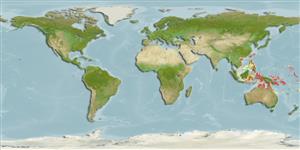>
Gobiiformes (Gobies) >
Gobiidae (Gobies) > Gobiinae
Etymology: Fusigobius: Latin, fusus = spindle + Latin, gobius = gudgeon (Ref. 45335); aureus: aureus (Latin for yellow) referring to the many 'golden-yellow' spots scattered on the body and fins (Ref. 31555).
Environment: milieu / climate zone / depth range / distribution range
Ecologia
marinhas associadas(os) a recifes; intervalo de profundidade 5 - 25 m (Ref. 90102). Tropical
Western Central Pacific: Indonesia, Solomon Islands, and the Coral Sea.
Tamanho / Peso / Idade
Maturity: Lm ? range ? - ? cm
Max length : 3.5 cm SL macho/indeterminado; (Ref. 31555)
Descrição suscinta
Chaves de identificação | Morfologia | Morfometria
Espinhos dorsais (total) : 7; Raios dorsais (total) : 9; Espinhos anais: 1; Raios anais : 8. Pectorals large and rounded; pelvic fins largely separated but united at base, the connecting membrane very short and concave in outer margin, without inter-spine frenum (Ref. 31555). Body with a row of golden-yellow spots along mid-line of lateral surfaces and with some rows of smaller golden-yellow spots on both dorsal and ventral surfaces. An oblique, yellow line on cheek and snout. Caudal base with a diaper-shaped black blotch. Dorsal and caudal fins with some rows of smaller golden-yellow spots. First dorsal with a large black blotch, with its lower half tinged orange. Pelvic fins largely separated except for a limited linkage by a very narrow connecting membrane (Ref. 31555); characterized further by having rounded caudal fin; longitudinal scale series 24-25; ctenoid body scales becoming cycloid anterior to pectoral and pelvic fins; absence of scales on operculum; opening of gill extending to or almost to vertical at posterior edge of preopercle; depth of body 4.3-4.8 in SL (Ref. 90102).
Inhabits seaward reefs in 5-25 m (Ref. 90102).
Ciclo de vida ou comportamento de acasalamento
Maturities | Reprodução | Spawnings | Egg(s) | Fecundities | Larvas
Chen, I.-S. and K.-T. Shao, 1997. Fusigobius aureus, a new species of gobiid fish (Perciformes, Gobiidae) from Flores Island, Indonesia. Acta Zool. Taiwanica 8(2):87-92. (Ref. 31555)
Status na Lista Vermelha da UICN (Ref. 130435)
Ameaça para os humanos
Harmless
Uso pelos humanos
Ferramentas
Relatórios especiais
Baixar XML
Fontes da internet
Estimates based on models
Preferred temperature (Ref.
123201): 27.4 - 29.4, mean 28.8 °C (based on 1078 cells).
Índice de diversidade filogenética (Ref.
82804): PD
50 = 0.5005 [Uniqueness, from 0.5 = low to 2.0 = high].
Bayesian length-weight: a=0.01023 (0.00477 - 0.02194), b=3.02 (2.84 - 3.20), in cm total length, based on LWR estimates for this (Sub)family-body shape (Ref.
93245).
Nível Trófico (Ref.
69278): 3.2 ±0.3 se; based on size and trophs of closest relatives
Resiliência (Ref.
120179): Elevada, tempo mínimo de duplicação da população menor que 15 meses (Preliminary K or Fecundity.).
Fishing Vulnerability (Ref.
59153): Low vulnerability (10 of 100).
